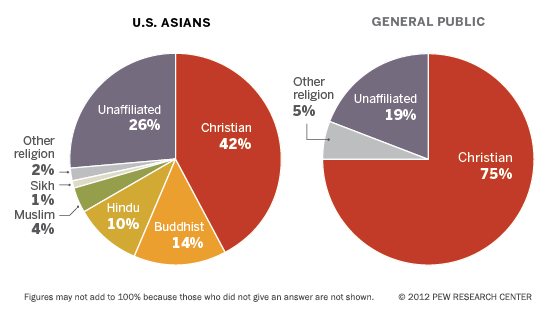Asian American Music and Religion: Scaffolding to Teach Hybridity and to Reduce Anxiety
Utilizing Popular Culture to Teach Asian American Religion
Colleagues have often suggested that I open class with popular culture in order to excite students for what comes next. However, I would caution that though this may seem like an unproblematic way to drive and to sustain student interest in historical, complex, or foreign course material, popular culture can upset and alienate students. Based on my experience teaching American art and popular culture, I understand that there will be students who react defensively to the material based on personal commitments, which is not unlike the majority of religious studies classrooms. Issues of race are also part of my courses on the religions and arts of American ethnic minorities, and these issues can make this challenging reaction more acute. I have devised a scaffold for my courses so as to calm student defensiveness and harness some of the emotions for student learning.
Yes, there are occasions when my pop culture references catch near universal joy, such as my recent “bow to your sensei—BOW TO YOUR SENSEI” Napoleon Dynamite quotation, but for the most part the use of popular culture aligns students in support or against the intended message. This tendency increases with student familiarity and heightens with the use of music by minorities, like hip-hop. For example, I had my most raucous reaction of grumblings, arguments, and proud support when I played Kanye West’s “New Slaves” for a class in summer 2013. When students are unfamiliar with the music, such as underground music or Asian American music, then they suspend judgment for a time. But soon they become familiar with it and will likewise determine their support or opposition. Another common student reaction is the feeling that the material is so obscure that it does not warrant their consideration.
These quick reactions of agreeing, disagreeing, and ignoring should be all too familiar to religious studies professors because we regularly have students eager to hear affirmations of their religious perspectives and some equally motivated to resist critiques. One reason for the defensive posture with regard to music is that music represents culture and identity, much like religion can. Another reason is that music regularly critiques specific aspects of other cultures, and students sympathetic to musical subcultures expect a reiteration of the same critiques. For these reasons, perspectives of popular culture that I bring to the classroom have the potential to make students feel uncomfortable, especially if they feel protective of their own culture(s) and if their opinions are not reproduced by the professor.
A further complication arises when discussing the music of Asian Americans: it often matches the form of popular music genres (hip-hop, rock, etc.), so the casual observer may think that it solely mimics those respective musical styles and contributes nothing unique. For example, Yo Yo Ma is a famous classical musician, Mike Shinoda is a well-known hip-hop MC (vocalist), and Pat Suzuki is a musical theatre icon, but they do not produce mere replicas of White American or African American music. Rather, their performances emanate from particular historical, social, and existential contexts. In this respect, part of my task is to provide tools to see through the exterior aspects of music, like lyrics and the images of music videos, and decipher influences, complex social negotiations, and the experience of performance. To bring students to this level of analysis while avoiding feelings of defensiveness, I engage a method of scaffolding courses so that students of many backgrounds and interests can analyze the hybridity of Asian American musical performance.
Scaffolding Method
The scaffolding method I use consists of four stages: Context, Traditions of Home, Non-Asian Influences, and New Experiences. This scaffolding roughly matches the outlines of immigration, so it provides a historical shape to a course. In addition, it allows students to transition from a familiar conception of religion as providing solace and community to a nuanced understanding of religion as a vehicle that can help one adjust and adapt worldviews, facilitate connections to other groups under common ideas and goals, and create visions of the future. This method challenges students to periodically reevaluate popular culture from other perspectives, analyze how it can create a sense of home and define one’s own “path,” and consider how performing popular culture can develop sensitivity to ancestral messages.
One example is Denizen Kane’s track “Han,” which I use in my Asian American Spirituality and Hip-Hop Hermeneutics courses. Denizen Kane is a Korean American hip-hop MC who draws upon his background in Christian Bible studies, Rastafarian prophecy, and Korean shamanism. In the piece “Han,” from the album Broken Speak by the spoken-word group I Was Born with Two Tongues, Kane ruminates on the Korean concept of han, which can roughly be described as the deep feelings of empathy toward the losses and struggles of family and community. It begins with the sounds of Korean shamanism, then over this music he discusses his grandparents’ immigration traumas, then it abruptly transitions to jazz bass and his words increase in intensity to a scathing critique of current Korean American realities.
I introduce this piece at the Non-Asian Influences stage of the course so that students can utilize their new knowledge of Asian American Context (scaffolding stage one) and draw upon the earlier section’s knowledge of how Asian immigrants transplant religion (Traditions of Home, stage two). Students in the Asian American Spirituality course would have been introduced to European colonization and twentieth-century wars in Asia that explain the significant presence of Christianity and the complex preservation of indigenous religions in Asia. Students in the Hip-Hop Hermeneutics course, which provides principles of interpretation across hip-hop cultures, would have been introduced to the process of ghettoization that is referenced directly and implicitly throughout hip-hop music. In hip-hop, among other aspects of cultural genocide, ghettoization is the imposition of straight lines on circular cultures, and hip-hop psychically deals with this reality by rebelling against linearity and by hyper-imposing it upon others. “Han” references these contexts with its lyrics and with the circularity of Korean music and African American jazz. Kane links words of DMX (an African American Christian hip-hop artist) to the DMZ (Korean Demilitarized Zone), which is a psychic, physical, and political cut that represents Korean Americans’ history of war and forced migration.
The song also challenges students to analyze how other American cultures become integrated with Asian cultures. “Han” is a clear example because it has two halves, one defined by Korean music and the other defined by jazz. The halves illustrate Kane’s psychic bifurcation and implicitly compare Korean shamanism to African American call-and-response, both of which have a prophetic function; therefore, the two halves are united or hybridized through religious purpose. The lyrics complement this analysis, so students can recognize that music and other kinds of human expression have multiple layers that can match the layers of history, society, and religion that they have been learning. Analyzing the process of hybridity through practice provides a foundation for students to comprehend other forms of Asian American hybridity. For example, we may analyze performances by Asian American b-boys and b-girls (hip-hop dancers) and uncover how circularity becomes dancers’ experiences of breaking out of structures of ghettoization and colonialism. Moreover, these dancers utilize a hybridized form of Asian and Africana religious traditions of mediumship and ancestor invocation that mirror Asian American cultural hybridity.
Lastly, the song sets up the next scaffolding stage, New Experiences, by providing examples of Asian Americans utilizing whatever is at their means to create their own paths, envision a different world, and integrate technology (in this case, hip-hop’s images and tools of technology). This detailed work enables students to understand that Asian Americans bring their historic experiences and cultural categories to contemporary art, including futuristic and consumerist art, and sometimes creating new forms of Asian American religiosity. This final scaffolding stage is also the locus of my own research, so it is rewarding for students to hear that the material challenges current researchers as well. To this end, I refer to my applications of performance theories of the body to origami, gardening, hip-hop, and other arts in order to understand Asian Americans’ embodied religious experiences when the appearance of the arts match Orientalized arts and African American arts (see for example: “Japanese American Appropriation of Folkloric Symbols” [2014] and “Multidimensional Silence, Spirituality, and the Japanese American Art of Gardening” [2013] ).
Minimizing Defensiveness and Building Confidence
The scaffolding technique I use also minimizes students’ feelings of defensiveness because it gradually builds foundations by drawing upon students’ academic lenses and cultures. I introduce the Context stage through history, sociology, and law in order for students to develop empathy towards the struggles of Asian Americans and to become informed about the multiple generations of American citizenship by some Asian Americans. The sections on Traditions of Home and Non-Asian Influences utilize students’ cultural backgrounds and current interests, and I incorporate theories of ritual, performance, and art for analysis. I also make sure to openly acknowledge these lenses and cultural influences at the start of each class. This includes noting other potential research areas and discoveries that we could engage but will not because of time and course trajectory. This enables students to feel that their perspectives may be valid, and that discussing a different perspective is not an attack on their perspectives and academic training but rather follows a different line of analysis. By spending time to prepare and slowly and carefully build student security, I find that I save time and reduce in-class stress because students are excited about the final New Experiences stage, which dives deep into the mundane and braves strange realities of popular culture. It is only at this point that students may be lightening their defenses and enjoying the material.
My use of scaffolding to increase learning and build student confidence has been influenced by several theorists. Building on Benjamin Bloom’s taxonomy of learning, each stage seeks to reach a higher level. The process of building security comes from Judith Langer’s theory of envisionment, which is a process of building students’ web of ideas. The concept of security also comes from theories of masculinity. Pierre Bourdieu’s theory of habitus and R.W. Connell’s understanding of the theory of the onto-formative articulate how symbols and meaning are inscribed on the body and constructed by the body. I understand from these theories that emotions are tied to an order of knowledge, and deviations from this order can lead to anxiety. Placing ideas in reference to this order helps to ease students’ feelings of defensiveness and thus cultivates the courage to think outside of it.
 Brett J. Esaki, PhD, is currently a postdoctoral teaching associate at Central Michigan University. He is an ethnographer and historian of Asian American and African American religions who received his doctorate in North American religions and a Certificate in College and University Teaching from the University of California, Santa Barbara in 2012. He also holds a master’s degree in African American religions from the University of South Carolina. He has published on Japanese American art and religion, especially the concept of silence, and is currently researching Asian American contemporary spirituality and its intersection with African American and Native American religions.
Brett J. Esaki, PhD, is currently a postdoctoral teaching associate at Central Michigan University. He is an ethnographer and historian of Asian American and African American religions who received his doctorate in North American religions and a Certificate in College and University Teaching from the University of California, Santa Barbara in 2012. He also holds a master’s degree in African American religions from the University of South Carolina. He has published on Japanese American art and religion, especially the concept of silence, and is currently researching Asian American contemporary spirituality and its intersection with African American and Native American religions.

